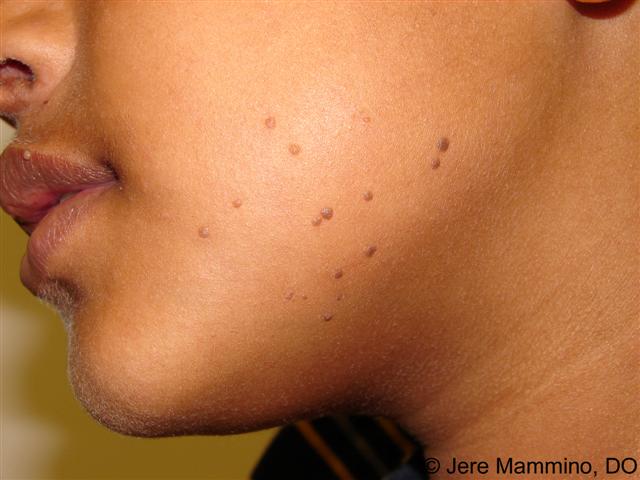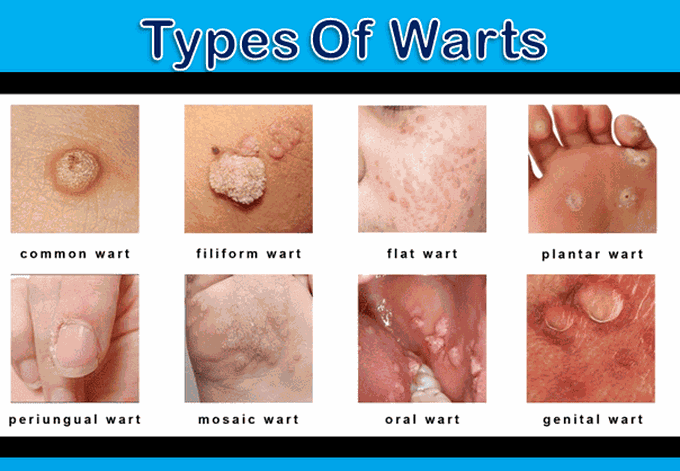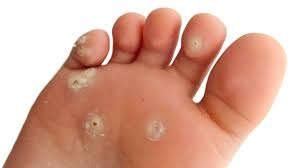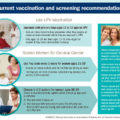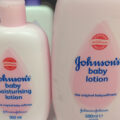What are warts?
Warts refers to noncancerous (benign) rough bumps that form on the skin. They develop when the human papillomavirus, or HPV, enters a cut or break in the skin and causes an infection.
Studies indicate that warts are common worldwide and affect approximately 10% of the population. In school-aged children, the prevalence is as high as 10% to 20%. They are more common among immunosuppressed patients and meat handlers.
Children are more prone to warts because they get a lot of cuts. Still, anyone can get warts. People with autoimmune disease or weakened immune systems, including the elderly, are more susceptible to the virus that causes warts.
What are the types of warts?
Wart types vary depending on the affected body part. Types include:
- Hands: These warts are called common warts because they are the most common type.
- Face: Flat warts affect the face and forehead.
- Feet: Plantar warts appear on the soles of the feet. These warts look like calluses with tiny black dots in the center. They are often painful and form in clusters.
- Genitals: Warts that form on the penis, vagina or rectum are called genital warts. These warts are a type of sexually transmitted infection. You get genital warts through sexual contact with an infected person.
- Periungual and subungual: These warts form under or around fingernails and toenails.
How do warts develop?
When the human papillomavirus (HPV) enters a cut in the skin, it causes a skin infection that forms warts. Warts are very contagious. The virus can spread from person to person or from different parts of the body through:
- Direct contact with a wart.
- Touching something contaminated with the virus, such as towels, doorknobs and shower floors.
- Sexual intercourse (genital warts).
- Nail biting and cuticle picking.
- Shaving.
How To Identify A Wart
According to the American Academy of Dermatology, there are a few different types of warts. The type is determined by where it grows on the body and what it looks like. The following describes the signs (what a person sees) and symptoms (what a person feels) for some of the different types of warts.
Common warts
(also called vurruca vulgaris)
Common warts have these traits:
- Grow most often on the fingers, around the nails, and on the backs of the hands.
- Are more common where skin was broken, such as from biting fingernails or picking at hangnails.
- Can have black dots that look like seeds (often called “seed” warts).
- Most often feel like rough bumps.
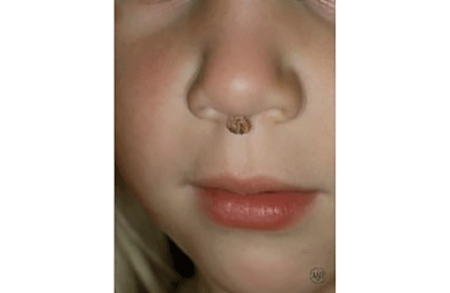
Wart under a child’s nose Photo Credit: AAD
Children frequently get common warts. If you see a wart on your child’s face, check your child’s hands for warts. The virus can spread from the hands to the face through touch or nail biting.
Foot warts
(also called plantar warts)
Plantar warts have these traits:
- Grow most often on the soles (plantar surface) of the feet
- Can grow in clusters (mosaic warts)
- Often are flat or grow inward (walking creates pressure, which causes the warts to grow inward)
- Can hurt, feels like you have pebbles in your shoe
- Can have black dots
These warts appear on the sole of the foot and can be hard to treat.
Flat warts
Flat warts have these traits:
- Can occur anywhere. Children usually get them on the face. Men get these most often in the beard area, and women tend to get them on their legs.
- Are smaller and smoother than other warts.
- Tend to grow in large numbers, 20 to 100 at a time.
Filiform warts
Filiform warts have these traits:
- Looks like long threads or thin fingers that stick out
- Often grows on the face: around the mouth, eyes, and nose
- Often grow quickly
How do dermatologists treat warts?
According to the American Academy of Dermatology, warts often go away without treatment. This is especially true when children get warts. In adults, warts may not disappear as easily or as quickly as they do in children. Although most warts are harmless, dermatologists do treat them.
You should see a dermatologist if you cannot get rid of the warts, the warts hurt, or you have many warts. Dermatologists have many treatments for warts. The treatment used depends on the patient’s age and health as well as the type of wart.
A dermatologist may use one of the following treatments:
- Cantharidin: A dermatologist may treat a wart in the office by “painting” it with cantharidin. Cantharidin causes a blister to form under the wart. In a week or so, you can return to the office and the dermatologist will clip away the dead wart.
- Cryotherapy: For common warts in adults and older children, cryotherapy (freezing) is the most common treatment. This treatment is not too painful. It can cause dark spots in people who have dark skin. It is common to need repeat treatments.
- Electrosurgery and curettage: Electrosurgery (burning) is a good treatment for common warts, filiform warts, and foot warts. Curettage involves scraping off (curetting) the wart with a sharp knife or small, spoon-shaped tool. These two procedures often are used together. The dermatologist may remove the wart by scraping it off before or after electrosurgery.
- Excision: The doctor may cut out the wart (excision). If the warts are hard-to-treat, the dermatologist may use one of the following treatments:
- Laser treatment: Laser treatment is an option, mainly for warts that have not responded to other therapies. Before laser treatment, the dermatologist may numb the wart with an anesthetic injection (shot).
- Chemical peels: When flat warts appear, there are usually many warts. Because so many warts appear, dermatologists often prescribe “peeling” methods to treat these warts. This means, you will apply a peeling medicine at home every day. Peeling medicines include salicylic acid (stronger than you can buy at the store), tretinoin, and glycolic acid.
- Bleomycin: The dermatologist may inject each wart with an anti-cancer medicine, bleomycin. The shots may hurt. They can have other side effects, such as nail loss if given in the fingers.
- Immunotherapy: This treatment uses the patient’s own immune system to fight the warts. This treatment is used when the warts remain despite other treatments. One type of immunotherapy involves applying a chemical, such as diphencyprone (DCP), to the warts. A mild allergic reaction occurs around the treated warts. This reaction may cause the warts to go away. Another type of immunotherapy involves getting shots of interferon. The shots can boost the body’s immune system, which gives the body the ability to fight the virus.
How to prevent warts
The virus that causes warts, human papillomavirus (HPV), spreads easily from person to person, and it’s found everywhere. For these reasons, it can be difficult to prevent warts completely.
By taking some precautions, you can reduce the risk of you and your family getting warts. For fewer warts, you’ll want to make sure everyone in your home follows these dermatologist-recommended precautions:
Avoid touching someone’s warts: HPV is contagious. It’s possible for the virus to get inside your body through a cut or scratch, which can cause a wart.
Make sure that everyone in your home has their own towels, washcloths, razors, nail clippers, socks, and other personal items: If someone in your home has a wart, this helps prevent the virus that causes warts from spreading from one person to another.
Clean and cover cuts and scrapes: HPV is everywhere. If you touch something contaminated with HPV, it’s easier for the virus to get inside your body through a cut or scrape, which could lead to a wart.
Wash your hands often: Because HPV is so common, this helps to remove the virus from your skin.
Prevent dry, cracked skin: When skin is cracked and dry, it’s easier for HPV to slip in through a crack in your skin, which could cause a wart.
Stop nail biting and cuticle chewing: When you bite your nails or cuticles, it causes sores and tears in the skin that are too tiny to see. These openings make it easier for HPV to get inside your body.
Wear flip-flops or pool shoes in locker rooms, pool areas, and public showers: HPV thrives in warm, moist areas. When your skin is moist and soft, it’s easier to get infected with HPV. Shoes and flip-flops help protect your feet from the virus, which can prevent plantar warts on your feet. Wearing flip-flops or other shoes in moist areas, such as piers, pool decks, and public showers can reduce your risk of developing warts on your feet.
Make sure your children get the HPV vaccine: This vaccine helps protect against genital warts and different cancers that could develop in the genital area. This vaccine is most protective when the person receives it before being exposed to the types of HPV that can cause genital warts and genital cancers. That’s why the Food and Drug Administration (FDA) approved it for children.
Treat hyperhidrosis: This is a medical condition that causes people to sweat excessively. People who have hyperhidrosis often sweat when other people feel comfortable or even cool. When people sweat frequently, their skin becomes damp and soft. Having damp, soft skin may increase the risk of getting HPV infection, which could lead to a wart.


